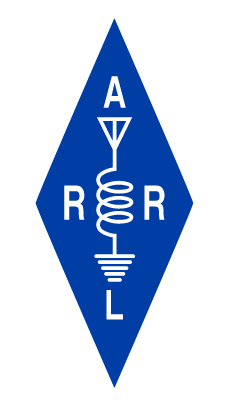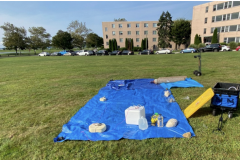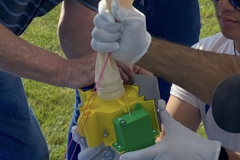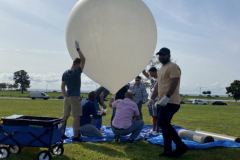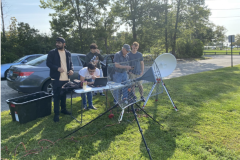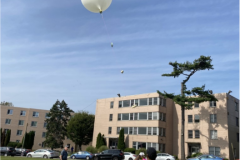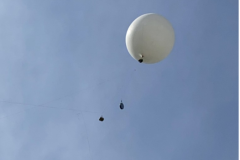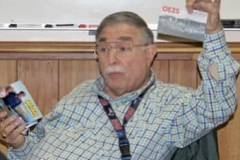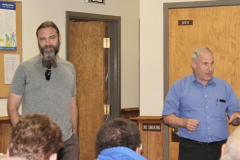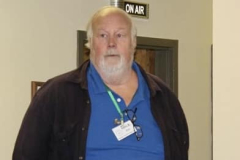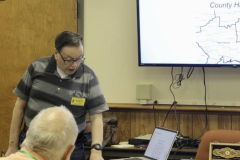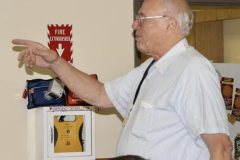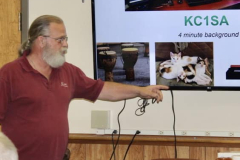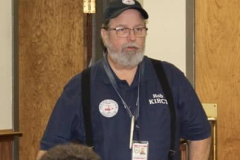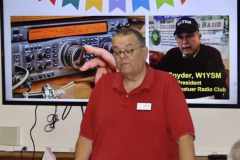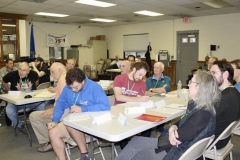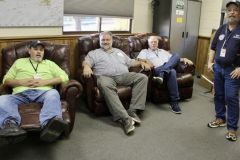NEAR-Fest, Deerfield NH, October 13-14, 2023
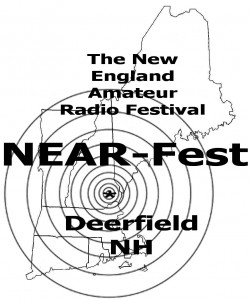 The New England Amateur Radio Festival (NEAR-Fest) will be held Friday October 13 and Saturday, October 14 at the Deerfield, New Hampshire, Fairgrounds. Besides the flea market, we will have a full slate of forums during the day on Friday. While we encourage everyone to attend the show, the forums will also be available to view on-line for those who cannot be present. The schedule (subject to change) can be viewed at: http://hamclass.net/nearf23.html. Details for viewing on line will appear the day before.
The New England Amateur Radio Festival (NEAR-Fest) will be held Friday October 13 and Saturday, October 14 at the Deerfield, New Hampshire, Fairgrounds. Besides the flea market, we will have a full slate of forums during the day on Friday. While we encourage everyone to attend the show, the forums will also be available to view on-line for those who cannot be present. The schedule (subject to change) can be viewed at: http://hamclass.net/nearf23.html. Details for viewing on line will appear the day before.
Further details on NEAR-Fest can be found at: https://near-fest.com/.
September 2023 Rhode Island Section News Now Available
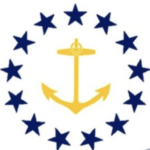 The Rhode Island September 2023 Section Newsletter is now available at <https://ri-arrl.org/ri-section-august-newsletter-september-31-2023/>.
The Rhode Island September 2023 Section Newsletter is now available at <https://ri-arrl.org/ri-section-august-newsletter-september-31-2023/>.
Maine Telegraph October 2023 Edition
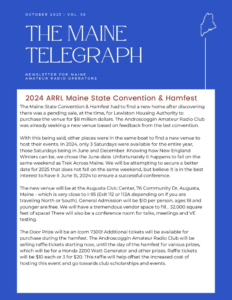 The October 2023 issue of the Maine Telegraph is available for viewing.
The October 2023 issue of the Maine Telegraph is available for viewing.
Emergency Alert System Test Message, October 4, 2023
 Anyone with a cellphone in the United States will hear an alarm go off on their device on October 4.
Anyone with a cellphone in the United States will hear an alarm go off on their device on October 4.
According to the Federal Emergency Management Agency (FEMA), at approximately 2:20 p.m. Eastern Time, a national test will be conducted of the Emergency Alert System (EAS) and Wireless Emergency Alerts.
The message on all consumer phones will read “THIS IS A TEST of the National Wireless Emergency Alert System. No action is needed.”
Those whose device is set to Spanish will receive a message that says “ESTA ES UNA PRUEBA del Sistema Nacional de Alerta de Emergencia. No se necesita acción.”
FEMA says the purpose of the test “is to ensure that the systems continue to be effective means of warning the public about emergencies, particularly those on the national level.
Fox Hunt, Wallingford CT, October 1, 2023
Dave Tipping, NZ1J, writes on the ctfoxhunter list on September 30, 2023 at 2:30 PM:
We’ll have a live Fox Hunt on Sunday from 9:30am until 11:00am. The Fox will be hidden somewhere in Wallingford.
We’ll be using these three frequencies:
There will be a 1 watt signal continuously on 146.565MHz. It will make a short beep every three seconds and will ID in Morse Code every minute.
The 10mW transmitter is on 147.455MHz and will beep every three seconds and will ID in Morse Code every minute.
The 1mW transmitter is on 146.290MHz and beeps every three seconds and ID as W1NRG in Morse Code every minute. Expect a range of only about 1/10 mile on this transmitter.
There is no central starting location. And, there will be no check-ins prior to the hunt. Hunters should be at a location of their own choosing and listening on 146.565 at 9:30.
There may be a two second long test of the 146.565 transmitter at 9:25.
Other Fox Hunters can be contacted on the W1NRG repeater 147.360 with PL 162.2 Hunters with an extra radio available might do well to monitor 147.360 throughout the hunt.
Good luck.
Dave NZ1J
Housatonic Amateur Radio Club Balloon Test “Highly Successful”
Members of the Housatonic Amateur Radio Club, Stratford CT, Dr. J. Pallis, KC1MHU, Gary Moyher, WE1M, and Larry Reed, AB1JC, along with University of Bridgeport and University of New Haven faculty and graduate students met at the University of Bridgeport’s Marina Park on September 22, 2023. There they put together the components of a balloon they will launch in Texas next month during the annular solar eclipse as part of NASA and Connecticut Space Grant Consortium’s 2023/2024 Solar Eclipse STEM projects. Here they tested the equipment with a tethered balloon full of helium.
It is estimated the balloon reached several hundred feet, which was sufficient to test the balloon, ground station, and the connections to University of Montana. The students practiced on the actual hardware they will use next month. All worked well, all was recovered and data was captured. This was a highly successful test. Students, university faculty and club members will fly to Texas next month to launch this payload during the annular solar eclipse and again fly to Texas in April, 2024, to launch another payload for the full Solar Eclipse.
ARISS Proposal Window Opens, October 1—November 10, 2023
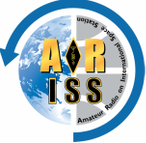 ARISS News Release No. 23-47
ARISS News Release No. 23-47
Dave Jordan, AA4KN
ARISS PR
FOR IMMEDIATE RELEASE
Message to US Educators
Amateur Radio on the International Space Station Contact Opportunity
Call for Proposals
New Proposal Window: October 1 – November 10, 2023
September 25, 2023 — The Amateur Radio on the International Space Station (ARISS) Program is seeking formal and informal education institutions and organizations, individually or working together, to host an Amateur Radio contact with a crew member on board the ISS. ARISS anticipates that the contact would be held between July 1, 2024 and December 31, 2024. Crew scheduling and ISS orbits will determine the exact contact dates. To maximize these radio contact opportunities, ARISS is looking for organizations that will draw large numbers of participants and integrate the contact into a well-developed education plan.
The deadline to submit a proposal is November 10, 2023. Proposal information and more details such as expectations, proposal guidelines and the proposal form can be found at www.ariss.org. An ARISS Proposal Webinar session will be held October 5 2023 at 7 PM ET and the Eventbrite link to sign up is: https://ariss-proposal-webinar-fall-2023.eventbrite.com
The Opportunity:
Crew members aboard the International Space Station will participate in scheduled Amateur Radio contacts. These radio contacts are approximately 10 minutes in length and allow students to interact with the astronauts through a question-and-answer session.
An ARISS contact is a voice-only communication opportunity via Amateur Radio between astronauts and cosmonauts aboard the space station and classrooms and their communities. ARISS contacts afford education audiences the chance to learn firsthand from astronauts what it is like to live and work in space and to learn about space research conducted on the ISS. Students also have an opportunity to learn about satellite communication, wireless technology, and radio science. Because of the nature of human spaceflight and the complexity of scheduling activities aboard the ISS, organizations must demonstrate flexibility to accommodate changes in dates and times of the radio contact.
Please direct any questions to education@ariss-usa.org.
About ARISS:
Amateur Radio on the International Space Station (ARISS) is a cooperative venture of international amateur radio societies and the space agencies that support the International Space Station (ISS). In the United States, sponsors are the American Radio Relay League (ARRL), Amateur Radio Digital Communications (ARDC), Radio Amateur Satellite Corporation (AMSAT), NASA’s Space Communications and Navigation program (SCaN) and the ISS National Lab—Space Station Explorers. The primary goal of ARISS is to promote exploration of science, technology, engineering, the arts, and mathematics topics. ARISS does this by organizing scheduled contacts via amateur radio between crew members aboard the ISS and students. Before and during these radio contacts, students, educators, parents, and communities take part in hands-on learning activities tied to space, space technologies, and amateur radio. For more information, see http://www.ariss.org.
Find us on social media at:
X – Twitter: ARISS_Intl
Facebook: facebook.com/ARISSIntl
Instagram: ariss_intl
Mastodon: ariss_intl@mastodon.hams.social
Check out ARISS on Youtube.com.
Meriden ARC Technician Class Kicks Off
Project BIG E Coverage in The ARRL Letter!
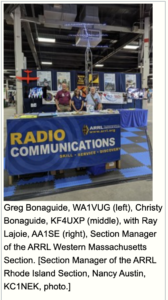 The September 21, 2023 issue of The ARRL Letter carried a news story about Project BIG E, the amateur radio booth-display at the BIG E in West Springfield, MA, that runs from September 15—October 1, 2023. Over 100,000 people read The ARRL Letter.
The September 21, 2023 issue of The ARRL Letter carried a news story about Project BIG E, the amateur radio booth-display at the BIG E in West Springfield, MA, that runs from September 15—October 1, 2023. Over 100,000 people read The ARRL Letter.
